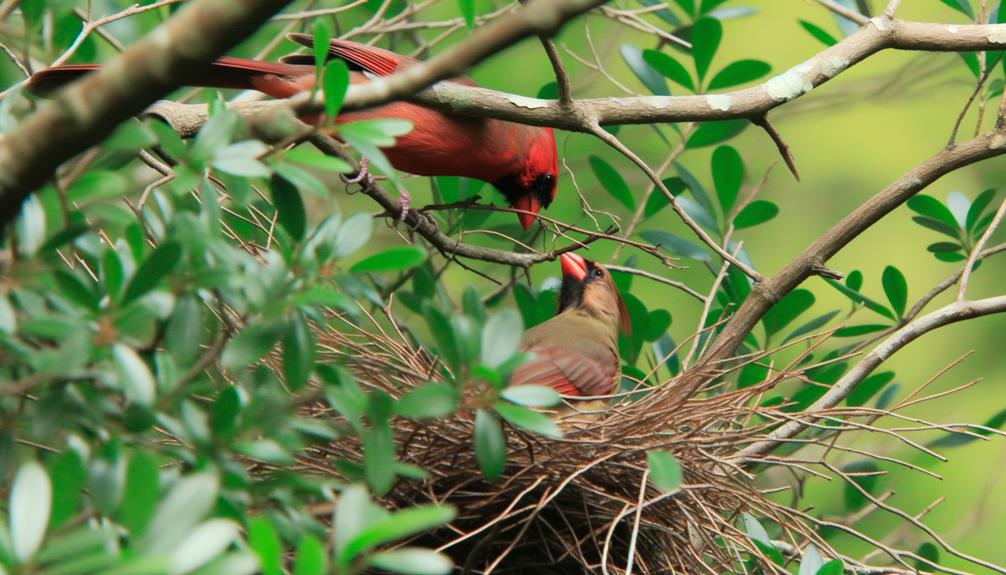What Does Each Male and Female Cardinal Do to Build the Nest?
The female cardinal primarily constructs the nest, choosing and intertwining twigs, leaves, and grass. She secures the nest's structural integrity and suitability for offspring survival.
The male cardinal doesn't directly build the nest but supports by gathering materials, defending the territory, and providing food. This division of labor enhances reproductive success.
Nests are usually constructed in dense shrubs or tree branches, 3-10 feet above ground, to guarantee camouflage from predators. The collaborative efforts between both sexes are essential for nest completion and offspring care.
To understand more about their intricate roles and behaviors, there's a wealth of information available.

Key Takeaways
- Female cardinals primarily construct the nest, weaving materials like twigs and grass.
- Male cardinals gather materials and provide resources but do not build the nest.
- Female cardinals select nesting sites and ensure structural integrity of the nest.
- Male cardinals defend the territory and assist by delivering nesting materials.
- Nest building is a collaborative effort, with females leading construction and males supporting.
Cardinal Gender Roles
In cardinals, gender roles are distinctly defined, with males primarily defending territory and females focusing on nest construction. You'll find that males are equipped with vibrant plumage, serving both to attract mates and to ward off rivals. Studies have shown that males spend approximately 70% of their active hours patrolling and defending the territory.
Conversely, females allocate a significant portion of their time to selecting the nest site, gathering materials, and constructing the nest. Data indicate that females initiate about 90% of nest-building activities. This division of labor ensures maximum efficiency in reproductive success.
Understanding these roles helps you appreciate the intricacies of cardinal behavior and the evolutionary strategies they employ for survival and reproduction.
Nest Building Process
You'll observe that the nest building process in cardinals is highly collaborative.
The female primarily selects the materials and constructs the nest, while the male assists by securing the location and providing additional resources.
This division of labor guarantees efficiency and maximizes reproductive success.
Materials and Location Selection
Cardinals meticulously choose nesting materials such as twigs, leaves, and grass, and select elevated, concealed locations to guarantee the safety and stability of their nests. They prioritize materials based on structural integrity and availability.
When selecting a nesting site, you'll observe they prefer dense shrubs or tree branches, typically 3-10 feet above ground, providing ideal camouflage from predators. Cardinals' choices reflect adaptive strategies for reproductive success.
Key considerations for nest materials include:
- Twigs: Primary structural component
- Leaves: Insulation and concealment
- Grass: Soft lining for egg protection
- Bark strips: Adds durability
- Vines: Reinforces nest structure
Construction Roles Explained
Both male and female cardinals display specific roles in the nest-building process, optimizing their efforts to secure the nest's structural integrity and suitability for raising chicks.
You'll find that the female primarily constructs the nest, meticulously weaving twigs, grasses, and other materials. This secures a sturdy and well-insulated environment for her future offspring.
While she focuses on construction, the male supports the process by gathering and delivering materials to the nest site. This division of labor allows the female to concentrate on the detailed assembly, enhancing the nest's overall quality.
Data indicate that such collaboration significantly boosts reproductive success, as it maximizes efficiency and secures the nest's completion within a critical timeframe for breeding.
Female Cardinal's Role
You'll observe that the female cardinal assumes primary responsibility for nest construction, meticulously weaving twigs and grasses.
This behavior showcases her strong maternal instincts, which are essential for the survival of her offspring.
Data indicates that her role is pivotal in ensuring the structural integrity and suitability of the nest for egg incubation.
Nest Construction Duties
The female cardinal primarily takes on the responsibility of nest construction. She meticulously gathers materials such as twigs, bark strips, grasses, and plant fibers to weave them into a secure and stable structure. Her role is essential for ensuring the durability and suitability of the nest for offspring.
You'll observe her selecting twigs, bark strips, grasses, and plant fibers to build a reliable nest.
Her key construction duties include:
- Material Selection: Choosing twigs, grasses, and plant fibers.
- Structural Weaving: Interlacing materials to form a stable base.
- Nest Shaping: Molding the structure into a cup-like shape.
- Location: Picking a tree fork or dense shrub for best protection.
- Layering: Adding softer materials like feathers and moss for cushioning.
Understanding these tasks highlights the female cardinal's important role in ensuring the nest's integrity and safety.
Maternal Instincts Displayed
In her role, the female cardinal demonstrates strong motherly instincts by carefully nurturing and safeguarding her eggs and fledglings. She's responsible for incubation, which lasts around 11-13 days. During this period, her body temperature control ensures ideal development conditions. After hatching, she continues to feed and protect the fledglings, guaranteeing their survival.
| Maternal Activity | Duration (Days) | Primary Responsibility |
|---|---|---|
| Incubation | 11-13 | Temperature regulation |
| Brooding | 9-11 | Feeding fledglings |
| Nest Guarding | Continuous | Predator defense |
You can observe that her motherly instincts are essential for the offspring's survival. The female's watchfulness and commitment contribute significantly to the fledglings' growth and readiness for independence.
Male Cardinal's Role
Male cardinals play a supportive yet crucial role in the nest-building process by gathering materials and defending the territory. Their contributions are necessary for successful reproduction. The male's responsibilities include:
- Collecting twigs, bark, and leaves for the female to weave into the nest.
- Vigilantly guarding the chosen nesting site from predators and rival males.
- Engaging in territorial displays to assert dominance and secure the nesting area.
- Providing food to the female during the incubation period to make sure she remains nourished.
- Participating in the feeding of hatchlings once they emerge.
Nest Materials and Location
Cardinals select a variety of natural materials like twigs, bark strips, and grasses to construct their nests, often choosing dense shrubs or tree branches to secure ideal concealment and protection. You'll find their nests typically located between 1 to 15 feet above ground, securing they're well-hidden from predators.
Nest construction involves layering coarse twigs for the outer structure, followed by finer materials such as grasses and bark strips for the inner lining. The use of pliable materials secures flexibility and durability. By choosing dense vegetation, cardinals minimize exposure to potential threats, enhancing the survival rate of their offspring.
This strategic selection of materials and locations exemplifies their adaptive nesting behavior in diverse environments.
Cooperation and Communication
While constructing their nest, both male and female cardinals engage in a coordinated effort, utilizing specific vocalizations and behaviors to enhance communication and efficiency.
You'll notice that cardinals use a series of calls and visual signals to synchronize their activities. This cooperation ensures the nest meets structural integrity and safety requirements.
Key cooperative behaviors include:
- Vocalizations: Specific calls to indicate the location of materials.
- Material Transfer: Males often fetch materials and pass them to females.
- Site Selection: Both sexes contribute to choosing the best site.
- Role Division: Females primarily construct while males provide support.
- Alert Signals: Both use alarm calls to warn of potential threats.
Observing Cardinal Behavior
To accurately study cardinal behavior, observe their interactions and activities during the early morning hours when they're most active. During this period, you'll notice distinct patterns.
Males often engage in singing to establish territories and attract mates. Females are more likely to be seen gathering nesting materials. Record the frequency and duration of these activities to identify trends.
Use binoculars and a notepad to document behaviors such as feeding, grooming, and nest-building. Pay attention to the division of labor; males typically provide food while females focus on construction.
Conclusion
In observing cardinal nest-building, you'll see the female primarily constructs the nest while the male provides materials and protection. This role division highlights their cooperation: the female meticulously arranges twigs and leaves, while the male stands guard.
Comparing their roles reveals a blend of precision and vigilance, ensuring both nest security and construction. Such coordinated behavior underscores the complex, interdependent nature of cardinal partnerships, exemplifying evolutionary advantages in task specialization and mutual support.






